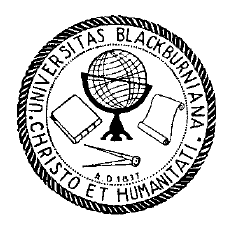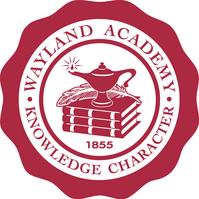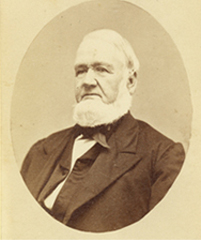
Easthampton is a city in Hampshire County, Massachusetts, United States. The city is in the Pioneer Valley near the five colleges in the college towns of Northampton and Amherst. The population was 16,211 at the 2020 census.
Phillips Academy is a co-educational university-preparatory school for boarding and day students in grades 9–12, along with a post-graduate year. The school is in Andover, Massachusetts, United States, 25 miles north of Boston. Phillips Academy has 1,131 students, and is highly selective, accepting 9% for the 2022–2023 school year. It is part of the Eight Schools Association and the Ten Schools Admissions Organization.

Groton School is a private college-preparatory day and boarding school located in Groton, Massachusetts. It is affiliated with the Episcopalian tradition.

William Smith Clark was an American professor of chemistry, botany, and zoology; a colonel during the American Civil War; and a leader in agricultural education. Raised and schooled in Easthampton, Massachusetts, Clark spent most of his adult life in Amherst, Massachusetts. He graduated from Amherst College in 1848 and obtained a doctorate in chemistry from Georgia Augusta University in Göttingen in 1852. He then served as professor of chemistry at Amherst College from 1852 to 1867. During the Civil War, he was granted leave from Amherst to serve with the 21st Regiment Massachusetts Volunteer Infantry, eventually achieving the rank of colonel and the command of that unit.

The New England Preparatory School Athletic Council (NEPSAC) is an organization that serves as the governing body for sports in preparatory schools and leagues in New England. The organization has 169 full member schools as well as 24 associate member schools. The associate member schools are from New England as well as outside the region, including Indiana, New Jersey, New York, and Ontario. The organization is headquartered in Hudson, Massachusetts.

Baylor School, commonly called Baylor, is a private, coeducational college-preparatory school in Chattanooga, Tennessee. Founded in 1893, the school's current campus comprises 690 acres and enrolls students in grades 6-12, including boarding students in grades 9-12. These students are served by Baylor's 148-member faculty, over two-thirds of whom hold advanced degrees, including nearly 40 adults who live on campus and serve as dorm parents. Baylor has had a student win the Siemens Award for Advanced Placement in math and science and a teacher received the National Siemens Award for Exemplary Teaching.

Kent School is a private, coeducational, college preparatory boarding school in Kent, Connecticut, established by Frederick Herbert Sill in 1906. It is affiliated with the Episcopal Church of the United States. It has a long history as an "elite school, not a school for elites," and innovated the sliding-scale tuition model in the early 20th century.

Hopkins School is a private, college-preparatory, coeducational, day school for grades 7–12 located in New Haven, Connecticut.
The Providence Country Day School is a co-educational independent school founded in 1923. Located in East Providence, Rhode Island, United States, it serves 375 students in grades PreK through 12. The school has no religious affiliation and has been co-ed since 1991. It has maintained accreditation by the New England Association of Schools and Colleagues (NEASC) since 1952.

Holworthy Hall, in Harvard Yard, Cambridge, Massachusetts, is a historic dormitory for first-year students at Harvard College.

Blackburn College is a private college in Carlinville, Illinois. It was established in 1837 and named for Gideon Blackburn. The college is affiliated with the Presbyterian Church (USA).

Rye Country Day School, also known as Rye Country Day or RCDS, is an independent, co-educational college preparatory school located in Rye, New York. Its Upper School, Middle School (5–8), and Lower School (Pre-Kindergarten-4) enroll a total of 886 students on its 35-acre campus. Rye Country Day attracts students from over 40 school districts in the tri-state area. The School's $5.9 million financial aid budget provides significant tuition grants to the families of 143 students (16%) in the school. 35% of RCDS students self-identify as people of color.

Wyoming Seminary, founded in 1844, is a Methodist college preparatory school located in the Wyoming Valley of Northeastern Pennsylvania. The "Lower School," which consists of preschool - 8th-grade students, is located in Forty Fort. The "Upper School," comprising 9th-grade to postgraduate students, is located in Kingston. It is near the Susquehanna River and the city of Wilkes-Barre. Locally and in some publications, it is sometimes referred to as "Sem." As a boarding school, only Upper School students may board on campus. Slightly more than one-third of the Upper School student body resides on campus.

Maine Central Institute (MCI) is an independent high school in Pittsfield, Maine, United States that was established in 1866. The school enrolls approximately 430 students and is a nonsectarian institution. The school has both boarding and day students.

Wayland Academy is a selective private, coeducational college preparatory boarding high school located in Beaver Dam, Wisconsin, United States. The student population at the beginning of the 2021–22 school year was 125. Nearly three-quarters of the students board at the school.

Tilton School is an independent, coeducational, college-preparatory school in Tilton, New Hampshire, serving students from 9th to 12th grade and postgraduate students. Founded in 1845, Tilton's student body in the 2021-22 academic year consisted of 61 day students and 129 boarding students. The typical student enrollment includes representation from 15-20 states and 10-15 countries.

Buxton School is a private, coeducational, college preparatory, and boarding and day school for grades 9–12 located in Williamstown, Massachusetts, US. As of 2023, the school had a student body of 68 students.

Saint Charles Borromeo Seminary is a Roman Catholic seminary in Wynnewood, Pennsylvania, that is under the jurisdiction of the Archdiocese of Philadelphia. The oldest Catholic institution of higher learning in the Philadelphia region, the school is named after Charles Borromeo, an Italian saint from the Counter-Reformation.

George Edward Denman was an American teacher and football, basketball, and baseball coach. He served as the third head football coach at Michigan Agricultural College, now known as Michigan State University, from 1901 to 1902, compiling a record of 7–9–1. Bemies was also the second head basketball coach at Michigan Agricultural from 1901 to 1903, tallying a mark of 11–0, and the head coach of Michigan Agricultural's baseball team from 1902 to 1903, where his record was 9–15–1.





















